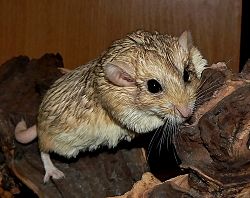Fat-tailed gerbil facts for kids
Quick facts for kids Pachyuromys duprasiTemporal range: Recent
|
|
|---|---|
 |
|
| Conservation status | |
| Scientific classification | |
| Kingdom: | |
| Phylum: | |
| Subphylum: | |
| Class: | |
| Order: | |
| Superfamily: | |
| Family: | |
| Subfamily: |
Gerbillinae
|
| Genus: |
Pachyuromys
Lataste, 1881
|
| Binomial name | |
| Pachyuromys duprasi |
|
The fat-tailed gerbil (Pachyuromys duprasi) is a small, furry rodent. It lives in the dry, sandy areas of North Africa. This gerbil is famous for its thick, carrot-shaped tail. This special tail helps the gerbil store fat and water. It's like a built-in pantry for when food or water is scarce!
Fat-tailed gerbils can live for 5 to 7 years when they are kept as pets. They are known for being calm and friendly.
Contents
About the Fat-Tailed Gerbil
Fat-tailed gerbils are also called Duprasi gerbils. They are a type of gerbil that belongs to the rodent family. They are quite small, usually about 10 to 13 centimeters (4 to 5 inches) long. Their tail adds another 5 centimeters (2 inches).
These gerbils have soft, fluffy fur. It is usually sandy-yellow or light brown on their back. Their belly is white. They have big, dark eyes and small ears. Their most unique feature is, of course, their tail!
Where Fat-Tailed Gerbils Live
Fat-tailed gerbils come from Africa. They live in the northern parts of the continent. Their natural home is in the Sahara Desert and nearby dry areas. This includes countries like Algeria, Egypt, Libya, Morocco, and Tunisia.
They prefer sandy or rocky deserts. These places often have sparse plants. They also need places to dig their burrows.
Life in the Wild
In the wild, fat-tailed gerbils are mostly active at night. This is because desert days are very hot. They spend the daytime sleeping in their cool, underground burrows. These burrows protect them from the sun and from predators.
They are very good at digging. Their burrows can be simple tunnels or more complex systems. They often have several entrances and different rooms. These rooms are used for sleeping, storing food, and raising their young.
What They Eat
Fat-tailed gerbils are omnivores. This means they eat both plants and insects. In their natural habitat, they eat seeds, roots, and leaves. They also hunt small insects like beetles and grasshoppers.
Because they live in dry places, they get most of their water from their food. Their bodies are very good at saving water. This means they can go a long time without drinking.
Special Adaptations
Fat-tailed gerbils have several amazing ways to survive in the desert.
- Fat Tail: As mentioned, their tail stores fat and water. When they have plenty to eat, their tail gets very plump. If food is scarce, their body uses the stored energy. The tail then becomes thinner.
- Water Conservation: They produce very little urine. This helps them save water. They also get moisture from the food they eat.
- Nocturnal Lifestyle: Being active at night helps them avoid the extreme heat of the desert day. It also helps them avoid some predators.
- Burrowing: Digging burrows keeps them cool in summer and warm in winter. It also provides a safe hiding spot.
Reproduction and Life Cycle
Fat-tailed gerbils usually breed in the warmer months. A female gerbil can have several litters (groups of babies) each year. After about 19 to 24 days, she gives birth to a litter of 3 to 6 tiny, blind, and hairless pups.
The mother takes care of her pups in the burrow. The pups grow quickly. They open their eyes after about two weeks. They start to explore outside the nest when they are about three weeks old. They become fully grown and independent around 6 to 8 weeks of age.
Fat-Tailed Gerbils as Pets
Fat-tailed gerbils are popular pets because they are gentle and rarely bite. They are also quiet and don't take up much space. They need a cage with plenty of bedding for digging. They also need a sand bath to keep their fur clean.
It's important to give them a balanced diet. This includes commercial gerbil food, fresh vegetables, and occasional insects. Providing a safe and stimulating environment helps them live a long and happy life.
See also
 In Spanish: Rata del desierto de cola crasa para niños
In Spanish: Rata del desierto de cola crasa para niños



